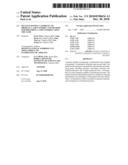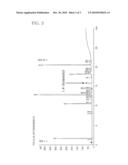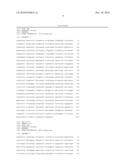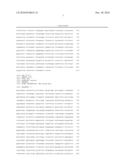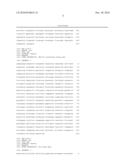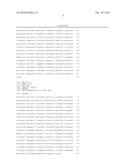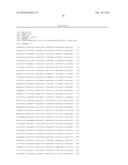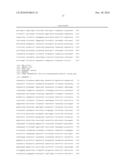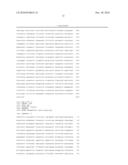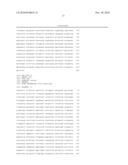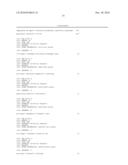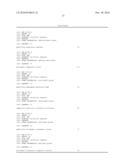Patent application title: Mutants Having Capability To Produce 1, 4-Butanediol And Method For Preparing 1, 4-Butanediol Using The Same
Inventors:
Si-Jae Park (Daejeon, KR)
Sang-Hyun Lee (Daejeon, KR)
Sang-Yup Lee (Daejeon, KR)
Eun-Jeong Lee (Daejeon, KR)
Eun-Jeong Lee (Daejeon, KR)
Assignees:
LG CHEM, LTD.
KOREA ADVANCED INSTITUTE OF SCIENCE AND TECHNOLOGY
IPC8 Class: AC12P718FI
USPC Class:
435158
Class name: Containing hydroxy group acyclic polyhydric
Publication date: 2010-12-30
Patent application number: 20100330634
Claims:
1. A mutant exhibiting high production of 1,4-butanediol, which is
prepared by introducing or amplifying genes encoding enzymes converting
succinate into 4-hydroxybutyrate, and 4-hydroxybutyrate into
1,4-butanediol, in a microorganism capable of producing succinate.
2. The mutant according to claim 1, wherein the microorganism capable of producing succinate is selected from the group consisting of bacterium, yeast and fungi that exhibit high production of succinate.
3. The mutant according to claim 2, wherein the bacterium is selected from the group consisting of Lumen bacteria, Corynebacterium species, Brevibacterium species and E. coli.
4. The mutant according to claim 3, wherein the Lumen bacteria have inactive genes encoding lactate dehydrogenase (ldhA) and pyruvate-formate lyase (pfl), and produce succinate in high concentration without substantial production of other organic acids in an anaerobic condition.
5. The mutant according to claim 3, wherein the Lumen bacteria have inactive genes encoding lactate dehydrogenase (ldhA), pyruvate-formate lyase (pfl), phosphotransacetylase (pta) and acetate kinase (ackA), and produce succinate in high concentration without substantial production of other organic acids in an anaerobic condition.
6. The mutant according to claim 3, wherein the Lumen bacteria have inactive genes encoding lactate dehydrogenase (ldhA), pyruvate-formate lyase (pfl) and phosphopyruvate carboxylase (ppc), and produce succinate in high concentration without substantial production of other organic acids in an anaerobic condition.
7. The mutant according to claim 3, wherein the Lumen bacteria are selected from the group consisting of Mannheimia species, Actinobacillus species and Anaerobiospirillum species.
8. The mutant according to claim 7, wherein the Lumen bacteria are Mannheimia species.
9. The mutant according to claim 8, wherein the Lumen bacteria are selected from the group consisting of Mannheimia succiniciproducens MBEL55E (KCTC 0769BP), and Mannheimia species LPK (KCTC 10558BP), LPK4 and LPK7 (KCTC 10626BP).
10. The mutant according to claim 3, wherein the E. coli has inactive genes encoding glucose phosphotransferase (ptsG) and pyruvate kinase (pykA and pykF), and produces succinate in high concentration without substantial production of other organic acids in an anaerobic condition.
11. The mutant according to claim 10, wherein the E. coli mutant is W3110GFA.
12. The mutant according to claim 1, wherein the gene encoding the enzyme converting succinate into 4-hydroxybutyrate is derived from Clostridium kluyveri.
13. The mutant according to claim 1, wherein the gene encoding the enzyme converting succinate into 4-hydroxybutyrate is selected from the group consisting of genes encoding succinyl-CoA transferase (Cat1), succinate semialdehyde dehydrogenase (SucD), 4-hydroxybutyrate dehydrogenase (4hbD) and 4-hydroxybutyrate dehydrogenase (GHB).
14. The mutant according to claim 13, wherein the gene encoding Cat1 has a base sequence of SEQ ID NO: 1, the gene encoding SucD has a base sequence of SEQ ID NO: 2, the gene encoding 4hbD has a base sequence of SEQ ID NO: 3, and the gene encoding GHB has a base sequence of SEQ ID NO: 4.
15. The mutant according to claim 13, wherein the mutant comprises a gene encoding Cat1; a gene encoding SucD; and a gene encoding 4hbD or a gene encoding GHB.
16. The mutant according to claim 1, wherein the gene encoding the enzyme converting 4-hydroxybutyrate into 1,4-butanediol is derived from Clostridium acetobutylicum.
17. The mutant according to claim 1, wherein the gene encoding the enzyme converting 4-hydroxybutyrate into 1,4-butanediol is a gene encoding 4-hydroxybutyrate-CoA transferase and a gene encoding alcohol dehydrogenase reducing 4-hydroxybutyrate-CoA; or a gene encoding phosphotransbutyrylase, a gene encoding butyryl kinase and a gene encoding alcohol dehydrogenase reducing 4-hydroxybutyrate-CoA.
18. The mutant according to claim 17, wherein the gene encoding 4-hydroxybutyrate-CoA transferase has a base sequence of SEQ ID NO: 5.
19. The mutant according to claim 17, wherein the gene encoding phosphotransbutyrylase and the gene encoding butyryl kinase have base sequences of by SEQ ID NOs: 6 and 7, respectively.
20. The mutant according to claim 17, wherein the alcohol dehydrogenase is butyl-CoA dehydrogenase derived from Clostridium acetobutylicum.
21. The mutant according to claim 20, wherein the gene encoding butyl-CoA dehydrogenase has a base sequence of SEQ ID NO: 8 or 9.
22. The mutant according to claim 1, wherein the mutant has an inactive gene associated with conversion of succinate semialdehyde into succinate.
23. The mutant according to claim 22, wherein the gene associated with conversion of succinate semialdehyde into succinate is a gene encoding succinic semialdehyde dehydrogenase (GabD).
24. The mutant according to claim 23, wherein the gene encoding GabD has a base sequence of SEQ ID NO: 10.
25. The mutant according to claim 1, wherein a gene encoding C4-dicarboxylate transport protein (DctA) associated with transport of succinate is further introduced or amplified in the mutant.
26. The mutant according to claim 25, wherein the gene encoding DctA has a base sequence of SEQ ID NO: 11.
27. A mutant exhibiting high production of 1,4-butanediol, which is prepared by introducing or amplifying a gene encoding Cat1; a gene encoding SucD; a gene encoding 4hbD or GHB; a gene encoding 4-hydroxybutyrate-CoA transferase, or a gene encoding Ptb and a gene encoding Buk; and a gene encoding butyl-CoA dehydrogenase, in a microorganism capable of producing succinate.
28. The mutant according to claim 27, wherein a gene encoding GabD is inactivated in the mutant.
29. The mutant according to claim 27, wherein a gene encoding DctA associated with transport of succinate is introduced or amplified in the mutant.
30. A method of preparing 1,4-butanediol, comprising:culturing the mutant according to claim 1 in a medium containing a carbon source; andobtaining 1,4-butanediol from the medium.
31. A butyl-CoA dehydrogenase gene having a base sequence of SEQ ID NO: 8 or 9.
32. A recombinant vector containing the gene according to claim 31.
Description:
TECHNICAL FIELD
[0001]The present invention relates to a mutant microorganism capable of producing 1,4-butanediol and a method of preparing 1,4-butanediol using the same.
BACKGROUND ART
[0002]Biodegradable polymers have been suggested as an alternative to synthetic polymers, which are one of the major causes of serious environmental pollution. Among various biodegradable polymers currently being developed, poly-β-hydroxybutyrate, a biodegradable polymer stored by various microorganisms in a state of unbalanced nutrition, has excellent characteristics such as biodegradability, water-resistance, piezoelectricity and biocompatibility. In particular, 4-hydroxybutyrate, an example of polyhydroxyalkanoate (PHA), has polyester-like characteristics and exhibits a wide range of properties from those of crystalline plastic to highly elastic rubber. Therefore, a considerable amount of research into microbial biodegradable plastic is presently being conducted.
[0003]Further, 4-hydroxybutyrate can be easily converted into various chemicals having 4 carbon atoms, such as 1,4-butanediol, γ-butyrolactone (GBL) and THF. In particular, 1,4-butanediol is an important industrial chemical in various forms such as polymer, solvent and a fine chemical intermediate. Although most chemicals having 4 carbon atoms are currently synthesized from 1,4-butanediol, maleic anhydride and so on, increasing production costs caused by an increase in the price of oil is necessitating development of another process for compensating and substituting a conventional chemical production process. A biological process has been suggested as such an alternative.
[0004]Meanwhile, succinate, dicarboxylic acid having 4 carbon atoms, is a kind of organic acid produced when a microorganism is cultured in an anaerobic condition. Now, various microorganisms are used as succinate-producing cells, and its production cost has become lower due to an effective fermentation process and development of a separation and purification process. Also, 4-hydroxybutyrate may be produced from succinate, and various organic acids having 4 carbon atoms can be derived from 4-hydroxybutyrate.
[0005]PCT Publication No. WO 2005/052135 is an example of a patent application disclosing a method of efficiently producing succinate, in which a Lumen bacterial mutant produces succinate in high concentration without producing other organic acids, and a method of preparing succinate using the mutant. In addition, a method of preparing an E. coli mutant capable of producing succinate in high concentration is disclosed in Korean Patent Application No. 10-2004-60149, and a method of preparing succinate using a novel gene is disclosed in Korean Patent Application Nos. 10-2005-0076301, 10-2005-0076317 and 10-2005-0076348.
[0006]As explained above, there is strong demand for a mutant capable of producing 1,4-butanediol, an industrially important chemical having 4 carbon atoms, and a biological method of preparing 1,4-butanediol using the mutant.
DISCLOSURE
Technical Problem
[0007]The present invention is directed to providing a mutant microorganism capable of producing 1,4-butanediol with high efficiency and a method of preparing 1,4-butanediol using the same.
Technical Solution
[0008]In one aspect, a microorganism capable of producing succinate, and preferably, a mutant exhibiting high production of 1,4-butanediol, in which a gene encoding an enzyme converting succinate into 4-hydroxybutyrate and a gene encoding an enzyme converting 4-hydroxybutyrate into 1,4-butanediol are introduced or amplified, and a method of preparing 1,4-butanediol using the same, are provided.
[0009]In another aspect, a butyl-CoA dehydrogenase gene of SEQ ID NO: 8 or 9, which effectively produces 1,4-butanediol from 4-hydroxybutyl-CoA, and a recombinant vector having the same are provided.
[0010]Hereinafter, the present invention will be described in more detail.
[0011]As a result of efforts to prepare 1,4-butanediol using a microorganism capable of producing succinate, the present inventors developed a mutant microorganism producing 1,4-butanediol by inducing or amplifying a gene associated with 4-hydroxybutyrate biosynthesis and/or a gene associated with 1,4-butanediol biosynthesis in the microorganism capable of producing succinate, and found that the mutant microorganism effectively produced 1,4-butanediol. This finding led to the present invention.
[0012]The term "amplification" used herein means an increase in gene expression level compared to original expression level. If there is no gene to be amplified in a microorganism before mutation, the at least one gene may be introduced to the microorganism and then amplified. And if there is a gene to be amplified in a microorganism before mutation, the at least one gene may be introduced to the microorganism by the same method described above, or a gene originally present in the microorganism may be manipulated by a genetic engineering technique to increase gene expression. For example, when a gene amplifying expression is present in a microorganism to be mutated, an original promoter for operating gene expression may be substituted with a stronger promoter, thereby amplifying gene expression.
[0013]The microorganism capable of producing succinate may exhibit high production of succinate, the microorganism being preferably one selected from the group consisting of bacteria, yeast and fungi, and more particularly, bacteria, for example, Lumen bacteria, Corynebacterium species, Brevibacterium species and E. coli.
[0014]The Lumen bacteria may have inactive genes encoding lactate dehydrogenase (ldhA) and pyruvate-formate lyase (pfl), and produce succinate in high concentration without other organic acids under anaerobic conditions.
[0015]The term "inactivation" used herein means that a gene is not transcribed due to mutation, or transcribed mRNA is not properly translated into original protein. In order to deactivate a gene, mutation may be conducted by missing a gene or changing a nucleic acid sequence of a gene.
[0016]Further, the Lumen bacteria may have inactive genes encoding lactate dehydrogenase (ldhA), pyruvate-formate lyase (pfl), phosphotransacetylase (pta) and acetate kinase (ackA), and produce succinate in high concentration without substantial production of other organic acids in an anaerobic condition.
[0017]Alternatively, the Lumen bacteria may have inactive genes encoding lactate dehydrogenase (ldhA), pyruvate-formate lyase (pfl) and phosphopyruvate carboxylase (ppc), and produce succinate in high concentration without substantial production of other organic acids in an anaerobic condition.
[0018]The Lumen bacteria may be selected from the group consisting of Mannheimia sp., Actinobacillus sp. and Anaerobiospirllum sp., but the present invention is not limited to these examples. Mannheimia sp. is preferable, and Mannheimia succiniciproducens MBEL55E (KCTC 0769BP), Mannheimia sp. LPK (KCTC 10558BP), LPK4 and LPK7 (KCTC 10626BP) are more preferable.
[0019]The E. coli may have inactive genes encoding glucose phosphotransferase (ptsG) and pyruvate kinase (pykA and pykF), and produce succinate in high concentration without substantial production of other organic acids in an anaerobic condition. In particular, the E. coli mutant is preferably W3110GFA disclosed in Korean Patent Publication No. 10-2006-0011345.
[0020]Among the above-mentioned microorganisms producing succinate in high concentration, the Lumen bacteria may be prepared in a method disclosed in PCT Publication No. WO 2005/052135. That is, a gene of lactic dehydrogenase (ldhA) and a gene of pyruvate-formate lyase (pfl) are inactivated in Mannheimia succiniciproducens 55E, thereby constructing a mutant strain, i.e., Mannheimia sp. LPK (KCTC 10558BP). Then, in the LPK strains, genes of phosphotransacetylase gene (pta) and acetate kinase gene (ackA), and a gene of phosphopyruvate carboxylase (ppc), are independently inactivated, thereby constructing mutant strains (Mannheimia sp. LPK7 and LPK4) which are then cultured in an anaerobic condition to produce succinate with high yield.
[0021]In addition, among the microorganisms producing succinate in high concentration, E. coli may be constructed by a method disclosed in Korean Patent Publication No. 10-2006-0011345. That is, mutant E. coli strain W3110GFA is yielded by inactivating a gene encoding glucose phosphotransferase (ptsG) and two genes encoding pyruvate kinase (pykA and pykF) in W3110 strain transformed with a recombinant expression vector expressing a bacteriophage red operon (exo-beta-gam). Then, when the mutant E. coli strain W3110GFA is cultured in an anaerobic condition, it can be confirmed that productivity of the mutant is greater than that of a mother strain W3110.
[0022]A gene of an enzyme converting the succinate into 4-hydroxybutyrate and a gene of an enzyme associated with conversion of the succinate semialdehyde into succinate may be derived from Clostridium kluyveri, and a gene of an enzyme converting the 4-hydroxybutyrate into 1,4-butanediol may be derived from Clostridium acetobutylicum. Although Clostridium kluyveri and Clostridium acetobutylicum do not produce 4-hydroxybutyrate and 1,4-butanediol, the enzymes cloned in these strains play an important role in producing 4-hydroxybutyrate and 1,4-butanediol.
[0023]Further, the gene of the enzyme converting succinate into 4-hydroxybutyrate may be selected from the group consisting of a gene encoding succinyl-CoA transferase a gene encoding succinate semialdehyde dehydrogenase (SucD), a gene encoding 4-hydroxybutyrate dehydrogenase (hbD), and a gene encoding 4-hydroxybutyrate dehydrogenase (GHB). Preferably, the gene encoding Cat1 has a base sequence of SEQ ID NO: 1, the gene encoding SucD has a base sequence of SEQ ID NO: 2, the gene encoding 4hbD has a base sequence of SEQ ID NO: 3, and the gene encoding GHB has a base sequence of SEQ ID NO: 4.
[0024]For example, a mutant microorganism according to the present invention may have a gene encoding Cat1, a gene encoding SucD and a gene encoding 4hbD, or a gene encoding Cat1, a gene encoding SucD and a gene encoding GHB, but the present invention is not limited to these examples.
[0025]Further, effective use of succinate is very important to accomplish the object of the present invention, and thus succinic semialdehyde dehydrogenase (GabD) associated with conversion of succinic semialdehyde into succinate may be removed from recombinant E. coli of the microorganisms producing succinate in high concentration. Therefore, the mutant microorganism according to the present invention may also have an inactive gene associated with conversion of succinate semialdehyde into succinate, which is preferably a gene encoding succinic GabD. The gene encoding GabD has a base sequence of SEQ ID NO: 10, but the present invention is not limited to the sequence.
[0026]Also, to effectively transport succinate in a microorganism, C4-dicarboxylate transport protein (DctA) enzyme associated with transport of succinate may be amplified. Thus, the mutant microorganism may further have a gene encoding Dct4 associated with transport of succinate, which is introduced thereinto or amplified, and a gene encoding Dct4 preferably has a base sequence of SEQ ID NO: 11.
[0027]The genes of enzymes converting 4-hydroxybutyrate into 1,4-butanediol may be genes encoding 4-hydroxybutyrate-CoA transferase and alcohol dehydrogenase reducing 4-hydroxybutyrate-CoA, or genes encoding phosphotransbutyrylase, butyryl kinase and alcohol dehydrogenase reducing 4-hydroxybutyrate-CoA.
[0028]The gene encoding 4-hydroxybutyrate-CoA transferase may have a base sequence of SEQ ID NO: 5, which may be substituted with phosphotransbutyrylase (ptb; SEQ ID NO: 6) and butyryl kinase (BuK; SEQ ID NO: 7) to convert 4-hydroxybutyrate into 4-hydroxybutyrate-CoA.
[0029]The alcohol dehydrogenase may be butyl-CoA dehydrogenase derived from Clostridium acetobutylicum, and the gene encoding butyl-CoA dehydrogenase preferably has a base sequence of SEQ ID NO: 8 or 9 (CAP0035 or CAP0162). The genes of SEQ. ID. NOs: 8 and 9 are very useful to produce 1,4-butanediol in the mutant microorganism according to the present invention. Accordingly, the present invention provides a gene encoding butyl-CoA dehydrogenase and a recombinant vector containing the same.
[0030]The term "vector" means a DNA construct containing a DNA sequence operably linked to a control sequence suitable for expressing DNA in a suitable host. In the present invention, the vector may comprise a plasmid vector, a bacteriophage vector, a cosmid vector, a Yeast Artificial Chromosome (YAC) vector, and preferably a plasmid vector. For example, the plasmid vector may have a constitution comprising (a) a replication origin for effective replication to have several hundreds of copies in one host cell, (b) an antibiotic-resistance gene for selecting a host cell transformed with the plasmid vector, and (c) a restriction enzyme site into which a foreign DNA fragment is capable of being inserted. Although there is no suitable restriction enzyme site, the vector may be easily ligated with the foreign DNA using a synthetic oligonucleotide adaptor or a linker according to a conventional method.
[0031]Therefore, the present invention provides a microorganism capable of producing succinate, and preferably, a mutant microorganism exhibiting high production of 1,4-butanediol in which a gene encoding GabD is inactivated, and all of a gene encoding Cat1, a gene encoding SucD, a gene encoding 4hbD (or GHB), a gene encoding 4-hydroxybutyrate-CoA transferase and a gene encoding butyl-CoA dehydrogenase are introduced or amplified.
[0032]Further, the present invention provides a microorganism capable of producing succinate, and preferably, a mutant microorganism exhibiting high production of 1,4-butanediol in which a gene encoding 4-hydroxybutyrate-CoA transferase (or a gene encoding phosphobutyrylase and a gene encoding butyryl kinase) and a gene encoding butyl-CoA dehydrogenase are introduced or amplified, and a method of preparing 1,4-butanediol using the same.
[0033]The present invention further provides a method of preparing 1,4-butanediol comprising culturing the mutant in a medium containing a carbon source, and obtaining 1,4-butanediol from the culture.
ADVANTAGEOUS EFFECTS
[0034]As described above in detail, the present invention provides a microorganism capable of producing succinate in high concentration, and more particularly, a mutant exhibiting high production of 1,4-butanediol that is a chemical having 4 carbon atoms having a wide range of important applications in chemical industry, and a biological method of preparing 1,4-butanediol using the same.
DESCRIPTION OF DRAWINGS
[0035]FIG. 1 is a schematic diagram of a pathway for producing 4-hydroxybutyrate from succinate;
[0036]FIG. 2 a schematic diagram of a pathway for producing 1,4-butanediol through 4-hydroxybutyrate produced from succinate; and
[0037]FIG. 3 shows GC analysis results of production of 1,4-butanediol.
MODES OF THE INVENTION
[0038]Hereinafter, the present invention will be described in more detail through examples. It will be clearly understood by those skilled in the art that the examples are provided merely to explain the present invention, not to limit its scope.
[0039]While, in the present invention, a method of preparing 1,4-butanediol uses Lumen bacteria such as mutants Mannheimia sp. LPK (KCTC 10558BP), LPK7 and LPK4, which have an inactive gene derived from a Mannheimia sp. strain and produce succinate in high concentration, E. coli and mutant E. coli W3110GFA, it will be also clearly understood by those skilled in the art that 1,4-butanediol may be produced by yielding a mutant producing succinate in high concentration using another Lumen bacteria strain, and introducing and amplifying a gene associated with producing 1,4-butanediol.
[0040]Further, while the following example provides a specific medium and culture method, it will be clearly understood by those skilled in the art that, as disclosed in the literatures (Lee et al., Bioprocess Biosyst. Eng., 26:63, 2003; Lee et al., Appl. Microbiol. Biotechnol., 58:663, 2002; Lee et al., Biotechnol. Lett., 25:111, 2003; Lee et al., Appl. Microbiol. Biotechnol., 54:23, 2000; and Lee et al., Biotechnol. Bioeng., 72:41, 2001), a medium used herein may be different from a hydrolysate such as whey or corn steep liquor, or various culture methods such as fed-batch culture and continuous culture may be used.
Example 1
Method of Preparing Microorganism Exhibiting High Production of Succinate
[0041]1-1. Preparation of Lumen Bacteria Having High Production of Succinate
[0042]A microorganism, a Lumen bacterium, exhibiting high production of succinate according to the present invention was prepared by the method disclosed in PCT Publication No. WO 2005/052135. That is, a mutant strain Mannheimia sp. LPK (KCTC 10558BP) was prepared by inactivating a gene of lactate dehydrogenase (ldhA) and a gene of pyruvate-formate lyase (pfl) in Mannheimia succiniciproducens 55E, which is one of the Lumen bacteria species, and mutant strains (Mannheimia sp. LPK7 and LPK4) were prepared by inactivating a gene of phosphotransacetylase (pta), a gene of acetate kinase (ackA) and a gene of phosphopyruvate carboxylase (ppc) in the LPK strain.
[0043]1-2. Preparation of E. Coli Exhibiting High Production of Succinate
[0044]A microorganism, E. coli, exhibiting high production of succinate according to the present invention was prepared by the method disclosed in Korean Patent Publication No. 10-2006-0011345. That is, a mutant E. coli strain W3110GFA was yielded by inactivating a gene encoding glucose phototransferase (ptsG) and two genes encoding pyruvate kinase (pykA and pykF) in W3110 strain, which was transformed with a recombinant expression vector pTrcEBG expressing a bacteriophage red operon (exo-beta-gam).
Example 2
Cloning of 1,4-Butanediol Converting Enzyme
[0045]2-1. Cloning of Genes Encoding 4-Hydroxybutyrate Converting Enzymes (Cat1, SucD and 4hbD)
[0046]The present inventors amplified cat1, sucD and 4hbD genes by polymerase chain reaction (PCR) using oligonucleotide primers synthesized based on a known gene sequence (L21902) in order to clone operons for genes encoding Cat1, SucD and 4hbD derived from Clostridium kluyveri DSM 555. The primers used for PCR were as follows.
TABLE-US-00001 SEQ ID NO 12: Cat1f-SacI 5'-tttcccgagctc TGTGAGGCGATTAAATGAGTAAAGGGATAAAG SEQ ID NO 13: 4hbDb-XabI gc tctaga tta gat aaa aaa gag gac att tca caa tat gg
[0047]To construct expression vector pTacLac4HB1, the operon for the amplified cat1, sucD and 4hbD genes were inserted into expression vector pTacLacI, which was cleaved with SacI/XbaI. The vector pTacLacI was constructed by cleaving vector pTac99A (Park and Lee, J. Bacteriol. 185, 5391-5397, 2003) with SspI, and ligating the cleaved vector with pTrc991 (Amersham Pharmacia Biotech), which was also cleaved with SspI. The vector pTacLacI has the same sequence as pTrc99A, and loses an NcoI restriction enzyme recognition site (restriction site) present in the pTrc99A from Multi Cloning sites (MCS). Here, the MCS started with an EcoRI site.
[0048]2-2. Cloning of Gene Encoding DctA Associated With Transport of Succinate
[0049]To clone a gene encoding DctA associated with transport of succinate in E. coli W3110, a DctA gene was amplified by DNA-PCR using oligonucleotide primers synthesized based on a known gene sequence (NC--000913). The primers used for PCR were as follows.
TABLE-US-00002 SEQ ID NO 14: DctAf-EcoRI ggaattc ATGAAAACCTCTCTGTTTAAAAGC SEQ ID NO 15: DctAb-XbaI gc tctaga tta aga gga taa ttc gtg cgt ttt gcc
[0050]To construct expression vector p10499DctA, the amplified DctA gene was cleaved with EcoRI/XbaI and then inserted into expression vector p10499A (Park et al. (2002) FEMS Microbiol. Lett 214:217-222).
[0051]2-3. Cloning of Gene Encoding Enzyme Converting 4-Hydroxybutyrate into 1,4-Butanediol
[0052]To clone genes encoding butyl-CoA dehydrogenase of SEQ ID NOs: 8 and 9, which are enzymes converting butyric acid into butanol in Clostridium acetobutylicum, cap0035 and cap0162 genes were amplified by DNA-PCR using oligonucleotide primers synthesized based on a known gene sequence (NC--003030). The primers used for PCR were as follows.
TABLE-US-00003 SEQ ID NO: 16: CAP0035f-SacI tttcccgagctc atgaaagttacaaatcaaaaa SEQ ID NO: 17: CAP0035b-XbaI gc tctaga tta aaa tgc ttt tat ata gat SEQ ID NO: 18: CAP0162f-EcoRI GGA ATT C atgaaagtcacaacagtaaag SEQ ID NO: 19: CAP0162b-XbaI gc tctaga tta agg ttg ttt ttt aaa
[0053]To construct expression vectors pTacLacCAP35 and pTacLacCAP162, the amplified cap0035 and cap0162 genes were independently inserted into expression vectors pTacLacI, which were cleaved with SacI/XbaI and EcoRI/XbaI.
[0054]To convert 4-hydroxybutyrate into 4-hydroxybutyrate-CoA, an operon of a Cat2 gene of SEQ ID NO: 5 was amplified by DNA-PCR using oligonucleotide primers synthesized based on the sequence of SEQ ID NO: 5. The primers for PCR were as follows.
TABLE-US-00004 SEQ ID NO: 20: cat2f-EcoRI ggaattc ATGGAGTGGGAAGAGATATATAAAGAG SEQ ID NO: 21: cat2b-BamHI cg ggatcc tta aaa tct ctt ttt aaa ttc att cat taa tg
[0055]To construct expression vector pTacLacCat2, the amplified cat2 gene was inserted into expression vector pTacLacI, which was cleaved with EcoRI/BamHI.
[0056]To convert 4-hydroxybutyrate into 4-hydroxybutyrate-CoA, operons for ptb and buk genes of SEQ ID NOs: 6 and 7 were amplified by DNA-PCR using oligonucleotide primers synthesized based on the sequences of SEQ ID NOs: 6 and 7. The primers used for PCR were as follows.
TABLE-US-00005 SEQ ID NO: 22: ptbf-RcoRI ggaattc ATGATTAAGAGTTTTAATGAAATATCATG SEQ ID NO: 23: bukb-XbaI gc tctaga tta ttt gta ttc ctt agc ttt ttc ttc tcc
[0057]To construct an expression vector, operons for the amplified ptb and buk genes were inserted into expression vector pTacLacI, which was cleaved with EcoRI/XbaI, thereby obtaining pTacLacPtbBuk. The vector pTacLacPtbBuk was cleaved with SspI to obtain a gene fragment including a tac promoter, the ptb and buk genes and a transcription terminator, and the gene fragment was inserted into vector pBBR1MCS2 (Kovach et al., Gene. 166:175, 1995) which was cleaved with EcoRV, thereby obtaining vector pMCS2TacPtbBuk.
Example 3
Yield of 1,4-BDO
[0058]Vectors pTacCAP162 and pMCS2Tacptbbuk were simultaneously transformed with E. coli XL1-Blue by electroporation and then plated on a LB plate containing 100 ug/ml ampicillin and 50 ug/ml kinamycin and cultured overnight at 37° C. The cultured colony was inoculated into a 15 ml tube (Falcon, USA) having 3 ml LB liquid medium containing 100 ug/ml ampicillin, and grown in a shaking incubator overnight at 200 rpm and 37° C. The incubated cells were inoculated into a fresh LB liquid medium containing 100 ml of 2% glucose and 100 ug/ml ampicillin, and then grown in a shaking incubator at 200 rpm and 37° C. When OD600 reached 0.7, IPTG was added at a final concentration of 1 mM to induce protein expression and the cells were cultured overnight.
[0059]Afterward, the culture was centrifuged and the supernatant was removed therefrom. Then, the cell pellet was washed with an MR medium once, resuspended in an MR medium containing 50 ml of 2% glucose, and 2% gamma-hydroxbutyrolactone and 1 mM IPTG, and fuzzed using gas mixture of 5% H2, 5% CO2 and N2 balance for 30 minutes to set up an anaerobic condition. The culture was grown in a shaking incubator overnight for about 3 days at 200 rpm and 37° C., and then centrifuged to obtain a supernatant. The obtained supernatant was concentrated two times, and used as a GC analysis sample for analysis to confirm production of 1,4-butanediol. The analysis was conducted under the following conditions, and the results are shown in FIG. 3.
[0060]Column: AT-Waw (0.53 mm ID×15 ml, 1.2 um u.f. capillary)
[0061]Gas Flow Rate: Column (He): 4.0 ml/min
[0062]Oven Temperature Initial Value & Time: 50° C., 5 min
[0063]Program Rate: 10° C./min
[0064]Final Value & Time: 250° C., 5 min
[0065]Injector Temperature: 250° C.
[0066]Detector Temperature: 250° C.
[0067]Injector Split Ratio: 20/1
[0068]Injector Volume: 1.0 ul
[0069]As shown in FIG. 3, it was confirmed that 1,4-butanediol was produced.
[0070]While the invention has been shown and described with reference to certain examples thereof, it will be understood by those skilled in the art that various changes in form and details may be made therein without departing from the spirit and scope of the invention as defined by the appended claims.
Sequence CWU
1
2311617DNAUnknownCat1-coding gene 1atgagtaaag ggataaagaa ttcacaattg
aaaaaaaaga atgtaaaggc tagtaatgtg 60gcagaaaaga ttgaagagaa agttgaaaaa
acagataagg ttgttgaaaa ggcagctgag 120gttactgaaa aacgaattag aaacttgaag
cttcaggaaa aagttgtaac agcagatgtg 180gcagctgata tgatagaaaa cggtatgatt
gttgcaatta gcggatttac tccttccggg 240tatcctaaag aagtacctaa agcattgact
aaaaaagtta atgccttaga ggaagaattc 300aaggtaacac tttatacagg ttcatctaca
ggagccgata tagacggaga atgggcaaaa 360gcaggaataa tagaaagaag aattccatat
cagacaaatt ctgatatgag gaaaaaaata 420aatgatggtt ctattaagta tgctgatatg
catttaagcc atatggctca atatattaat 480tattctgtaa ttcctaaagt agatatagct
ataatagagg cagtagctat tacagaagaa 540ggggatatta ttccttcaac aggaattgga
aatacagcta cttttgtgga aaatgcagat 600aaggtaatag tggaaattaa tgaggctcaa
ccgcttgaat tggaaggtat ggcagatata 660tatacattaa aaaaccctcc aagaagagag
cccataccta tagttaatgc aggcaatagg 720atagggacca catatgtgac ctgtggttct
gaaaaaatat gcgctatagt gatgacaaat 780acccaggata aaacaagacc tcttacagaa
gtgtctcctg tatctcaggc tatatccgat 840aatcttatag gatttttaaa taaagaggtt
gaagagggaa aattacctaa gaacctgctt 900cctatacagt caggagttgg aagtgtagca
aatgcagttt tggccggact ttgtgaatca 960aattttaaaa atttgagttg ttatacagaa
gttatacagg attctatgct gaagcttata 1020aaatgtggta aagcagatgt ggtgtcaggc
acttccataa gtccttcacc ggagatgttg 1080cctgagttca taaaggacat aaatttcttt
agagaaaaga tagtattaag accacaggaa 1140ataagtaata atccagagat agcaagaaga
ataggagtta tatccataaa cactgctttg 1200gaagtagata tatatggtaa tgtaaactcc
actcatgtta tgggaagcaa aatgatgaat 1260ggtataggcg gttctggaga ctttgccaga
aatgcatatt tgactatatt cactacagag 1320tctatcgcca aaaaaggaga tatatcatct
atagttccta tggtatccca tgtggatcat 1380acagaacatg atgtaatggt aattgttaca
gaacagggag tagcagattt aagaggtctt 1440tctcctaggg aaaaggccgt ggctataata
gaaaattgtg ttcatcctga ttacaaggat 1500atgcttatgg aatattttga agaggcttgt
aagtcatcag gtggaaatac accacataat 1560cttgaaaaag ctctttcctg gcatacaaaa
tttataaaaa ctggtagtat gaaataa 161721419DNAUnknownSucD-coding gene
2atgagtaatg aagtatctat aaaagaatta attgaaaagg caaaggcggc acaaaaaaaa
60ttggaagcct atagtcaaga acaagttgat gtactagtaa aagcactagg aaaagtggtt
120tatgataatg cagaaatgtt tgcaaaagaa gcagttgaag aaacagaaat gggtgtttat
180gaagataaag tagctaaatg tcatttgaaa tcaggagcta tttggaatca tataaaagac
240aagaaaactg taggcataat aaaagaagaa cctgaaaggg cacttgttta tgttgctaag
300ccaaagggag ttgtggcagc tactacgcct ataactaatc cagtggtaac tcctatgtgt
360aatgcaatgg ctgctataaa gggcagaaat acaataatag tagcaccaca tcctaaagca
420aagaaagttt cagctcatac tgtagaactt atgaatgctg agcttaaaaa attgggagca
480ccagaaaata tcatacagat agtagaagca ccatcaagag aagctgctaa ggaacttatg
540gaaagtgctg atgtagttat tgctacaggc ggtgctggaa gagttaaagc tgcttactcc
600agtggaagac cagcttatgg cgttggacct ggaaattcac aggtaatagt tgataaggga
660tacgattata acaaagctgc acaggatata ataacaggaa gaaaatatga caatggaatt
720atatgttctt cagagcaatc agttatagct cctgctgaag attatgataa ggtaatagca
780gcttttgtag aaaatggggc attctatgta gaagatgagg aaacagtaga aaagtttaga
840tcaactttat ttaaagatgg aaaaataaac agcaagatta taggtaaatc cgtccaaatt
900attgcggatc ttgcaggagt aaaagtacca gaaggtacta aggttatagt acttaagggt
960aaaggtgcag gagaaaaaga tgtactttgt aaagaaaaaa tgtgtccagt tttagtagca
1020ttgaaatatg atacttttga agaagcagtt gaaatagcta tggctaatta tatgtatgaa
1080ggagctggtc atacagcagg catacattct gacaatgacg agaacataag atatgcaaga
1140actgtattac ctataagcag attagttgta aatcagcctg caactactgc tggaggaact
1200gtattaccta taagcagatt agttgtaaat cagcctgcaa ctactgctgg aggaagtttc
1260aataatggat ttaaccctac tactacacta ggctgcggat catggggcag aaacagtatt
1320tcagaaaatc ttacttacga gcatcttata aatgtttcaa gaatagggta tttcaataaa
1380gaagcaaaag ttcctagcta tgaggaaata tggggataa
141931116DNAUnknown4hbD-coding gene 3atgaagttat taaaattggc acctgatgtt
tataaatttg atactgcaga ggagtttatg 60aaatacttta aggttggaaa aggtgacttt
atacttacta atgaattttt atataaacct 120ttccttgaga aattcaatga tggtgcagat
gctgtatttc aggagaaata tggactcggt 180gaaccttctg atgaaatgat aaacaatata
attaaggata ttggagataa acaatataat 240agaattattg ctgtaggggg aggatctgta
atagatatag ccaaaatcct cagtcttaag 300tatactgatg attcattgga tttgtttgag
ggaaaagtac ctcttgtaaa aaacaaagaa 360ttaattatag ttccaactac atgtggaaca
ggttcagaag ttacaaatgt atcagttgca 420gaattaaaga gaagacatac taaaaaagga
attgcttcag acgaattata tgcaacttat 480gcagtacttg taccagaatt tataaaagga
cttccatata agttttttgt aaccagctcc 540gtagatgcct taatacatgc aacagaagct
tatgtatctc caaatgcaaa tccttatact 600gatatgttta gtgtaaaagc tatggagtta
attttaaatg gatacatgca aatggtagag 660aaaggaaatg attacagagt tgaaataatt
gaggattttg ttataggcag caattatgca 720ggtatagctt ttggaaatgc aggagtggga
gcggttcacg cactctcata tccaataggc 780ggaaattatc atgtgcctca tggagaagca
aattatctgt tttttacaga aatatttaaa 840acttattatg agaaaaatcc aaatggcaag
attaaagatg taaataaact attagcaggc 900atactaaaat gtgatgaaag tgaagcttat
gacagtttat cacaactttt agataaatta 960ttgtcaagaa aaccattaag agaatatgga
atgaaagagg aagaaattga aacttttgct 1020gattcagtaa tagaaggaca gcagagactg
ttggtaaaca attatgaacc tttttcaaga 1080gaagacatag taaacacata taaaaagtta
tattaa 111641460DNAUnknownGHB-coding gene
4gaattgtgaa cgatcgctcg attttagtat gatgccagat gttccaggtg cccggcagta
60cgagataacc ccgaaaagtc gctgtcagcc tgccacgcgg caagtttttg cgcgatgatc
120ggctgaagcg gtcccgaggg ctccggaaac gcagtagtgc aggtccattg aaacccaaga
180cagcgggcct ggcgagcatc cgctccaggc ccgtgcaaaa gacaatttgg cggcagatcc
240cggcaggaga caagcaaaca tggcgtttat ctactatctg acccacatcc acctggattt
300cggcgcggta agcctgctca agtccgaatg cgagcgcatc ggcatccgcc gcccgttgct
360ggtgaccgac aagggcgtgg tcgccgcggg agtggcgcag cgtgccatcg atgcaatgca
420gggcctgcag gttgcggtat tcgatgaaac cccgtcgaac ccgaccgagg ccatggtgcg
480caaggccgcc gcacaatacc gcgaggccgg ctgcgacggg ctggtggcag tgggcggcgg
540ctcgtcgatc gacctcgcca agggcatcgc catcctggcc acgcatgagg gcgagctgac
600cacctatgcc accatcgaag gcggcagcgc caggatcacc gacaaggcgg cgccgctgat
660cgcggtgccc accacctcgg gcaccggcag cgaggtggcg cgcggcgcca tcatcatcct
720ggacgacggc cgcaagctgg gcttccattc ctggcatttg ctgcccaagt ccgccgtctg
780cgacccggaa ctgacgctgg ggctgccggc cgggctgacc gcggccaccg gcatggatgc
840gatcgcgcac tgcatcgaga ccttcctggc ccccgccttc aacccgcccg cggacggcat
900tgcgctggac gggctggagc gcggctgggg ccatatcgaa cgcgccaccc gcgacggtca
960ggaccgcgac gcacgcctga acatgatgag cgcgtcgatg cagggcgcaa tggcgttcca
1020gaaggggctg ggctgcgtgc attcgctgtc gcacccgctg ggcgggctga agatcgacgg
1080ccgcaccggc ctgcaccacg gcacgctcaa cgcggtggtg atgccggcgg tgctgcgctt
1140caacgccgat gcgcccacgg tggtgcgcga cgaccgctac gcacgcctgc gccgcgccat
1200gcacctgccc gacggcgccg atatcgcgca ggccgtgcac gacatgaccg tgcgcctggg
1260cctgcccacc gggctgcgtc agatgggtgt caccgaggac atgttcgaca aggtgattgc
1320cggtgcgctg gtcgaccatt gccacaagac caacccgaaa gaagccagcg ccgcggatta
1380tcggcgtatg cttgagcagt ccatgtagca cacagcggct tcccgccggt cagaccgacc
1440aagcggctgt ccggcggccc
146051290DNAUnknown4HB-CoA transferase-coding gene 5atggagtggg aagagatata
taaagagaaa ctggtaactg cagaaaaagc tgtttcaaaa 60atagaaaacc atagcagggt
agtttttgca catgcagtag gagaacccgt agatttagta 120aatgcactag ttaaaaataa
ggataattat ataggactag aaatagttca catggtagct 180atgggcaaag gtgtatatac
aaaagagggt atgcaaagac attttagaca taatgctttg 240tttgtaggcg gatctactag
agatgcagta aattcaggaa gagcagttta tacaccttgt 300tttttctatg aagtgccaag
tttgtttaaa gaaaaacgtt tgcctgtaga tgtagcactt 360attcaggtaa gtgagccaga
taaatatggc tactgcagtt ttggagtttc caatgactat 420accaagccag cagcagaaag
tgctaagctt gtaattgcag aagtgaataa aaacatgcca 480agaactcttg gagattcttt
tatacatgta tcagatattg attatatagt ggaagcttca 540cacccattgt tagaattgca
gcctcctaaa ttgggagatg tagaaaaagc cataggagaa 600aactgtgcat ctttaattga
agatggagct actcttcagc ttggaatagg tgctatacca 660gatgcggtac ttttattctt
aaagaacaaa aagaatttag gaatacattc tgagatgata 720tcagatggtg tgatggaact
ggtgaaggca ggggttatca ataacaagaa aaagaccctc 780catccaggca aaatagttgt
aacattttta atgggaacaa aaaaattata tgattttgta 840aacaataatc caatggtaga
aacttattct gtagattatg taaataatcc actggtaatt 900atgaaaaatg acaatatggt
ttcaataaat tcttgtgttc aagtagactt aatgggacaa 960gtatgttctg aaagtatagg
attgaaacag ataagtggag tgggaggcca ggtagatttt 1020attagaggag ctaatctatc
aaagggtgga aaggctatta tagctatacc ttccacagct 1080ggaaaaggaa aagtttcaag
aataactcca cttctagata ctggtgctgc agttacaact 1140tctagaaatg aagtagatta
tgtagttact gaatatggtg ttgctcatct taagggcaaa 1200actttaagaa atagggcaag
agctctaata aatatcgctc atccaaaatt cagagaatca 1260ttaatgaatg aatttaaaaa
gagattttag
12906906DNAUnknownPtb-coding gene 6gtgattaaga gttttaatga aattatcatg
aaggtaaaga gcaaagaaat gaaaaaagtt 60gctgttgctg tagcacaaga cgagccagta
cttgaagcag taagagatgc taagaaaaat 120ggtattgcag atgctattct tgttggagac
catgacgaaa tcgtgtcaat cgcgcttaaa 180ataggaatgg atgtaaatga ttttgaaata
gtaaacgagc ctaacgttaa gaaagctgct 240ttaaaggcag tagagcttgt atcaactgga
aaagctgata tggtaatgaa gggacttgta 300aatacagcaa ctttcttaag atctgtatta
aacaaagaag ttggacttag aacaggaaaa 360actatgtctc acgttgcagt atttgaaact
gagaaatttg atagactatt atttttaaca 420gatgttgctt tcaatactta tcctgaatta
aaggaaaaaa ttgatatagt aaacaattca 480gttaaggttg cacatgcaat aggaattgaa
aatccaaagg ttgctccaat ttgtgcagtt 540gaggttataa accctaaaat gccatcaaca
cttgatgcag caatgctttc aaaaatgagt 600gacagaggac aaattaaagg ttgtgtagtt
gacggacctt tagcacttga tatagcttta 660tcagaagaag cagcacatca taagggagta
acaggagaag ttgctggaaa agctgatatc 720ttcttaatgc caaacataga aacaggaaat
gtaatgtata agactttaac atatacaact 780gattcaaaaa atggaggaat cttagttgga
acttctgcac cagttgtttt aacttcaaga 840gctgacagcc atgaaacaaa aatgaactct
atagcacttg cagctttagt tgcaggcaat 900aaataa
90671068DNAUnknownBuk-coding gene
7atgtatagat tactaataat caatcctggc tcgacctcaa ctaaaattgg tatttatgac
60gatgaaaaag agatatttga gaagacttta agacattcag ctgaagagat agaaaaatat
120aacactatat ttgatcaatt tcaattcaga aagaatgtaa ttttagatgc gttaaaagaa
180gcaaacatag aagtaagttc tttaaatgct gtagttggaa gaggcggact cttaaagcca
240atagtaagtg gaacttatgc agtaaatcaa aaaatgcttg aagaccttaa agtaggagtt
300caaggtcagc atgcgtcaaa tcttggtgga attattgcaa atgaaatagc aaaagaaata
360aatgttccag catacatagt tgatccagtt gttgtggatg agcttgatga agtttcaaga
420atatcaggaa tggctgacat tccaagaaaa agtatattcc atgcattaaa tcaaaaagca
480gttgctagaa gatatgcaaa agaagttgga aaaaaatacg aagatcttaa tttaatcgta
540gtccacatgg gtggaggtac ttcagtaggt actcataaag atggtagagt aatagaagtt
600aataatacac ttgatggaga aggtccattc tcaccagaaa gaagtggtgg agttccaata
660ggagatcttg taagattgtg cttcagcaac aaatatactt atgaagaagt aatgaaaaag
720ataaacggca aaggcggagt tgttagttac ttaaatacta tcgattttaa ggctgtagtt
780gataaagctc ttgaaggaga taagaaatgt gcacttatat atgaagcttt cacattccag
840gtagcaaaag agataggaaa atgttcaacc gttttaaaag gaaatgtaga tgcaataatc
900ttaacaggcg gaattgcgta caacgagcat gtatgtaatg ccatagagga tagagtaaaa
960ttcatagcac ctgtagttag atatggtgga gaagatgaac ttcttgcact tgcagaaggt
1020ggacttagag ttttaagagg agaagaaaaa gctaaggaat acaaataa
106882577DNAUnknownButyl-CoA dehydrogenase(CAP0035)-coding gene
8atgaaagtta caaatcaaaa agaactaaaa caaaagctaa atgaattgag agaagcgcaa 60
aagaagtttg caacctatac tcaagagcaa gttgataaaa tttttaaaca atgtgccata
120gccgcagcta aagaaagaat aaacttagct aaattagcag tagaagaaac aggaataggt
180cttgtagaag ataaaattat aaaaaatcat tttgcagcag aatatatata caataaatat
240aaaaatgaaa aaacttgtgg cataatagac catgacgatt ctttaggcat aacaaaggtt
300gctgaaccaa ttggaattgt tgcagccata gttcctacta ctaatccaac ttccacagca
360attttcaaat cattaatttc tttaaaaaca agaaacgcaa tattcttttc accacatcca
420cgtgcaaaaa aatctacaat tgctgcagca aaattaattt tagatgcagc tgttaaagca
480ggagcaccta aaaatataat aggctggata gatgagccat caatagaact ttctcaagat
540ttgatgagtg aagctgatat aatattagca acaggaggtc cttcaatggt taaagcggcc
600tattcatctg gaaaacctgc aattggtgtt ggagcaggaa atacaccagc aataatagat
660gagagtgcag atatagatat ggcagtaagc tccataattt tatcaaagac ttatgacaat
720ggagtaatat gcgcttctga acaatcaata ttagttatga attcaatata cgaaaaagtt
780aaagaggaat ttgtaaaacg aggatcatat atactcaatc aaaatgaaat agctaaaata
840aaagaaacta tgtttaaaaa tggagctatt aatgctgaca tagttggaaa atctgcttat
900ataattgcta aaatggcagg aattgaagtt cctcaaacta caaagatact tataggcgaa
960gtacaatctg ttgaaaaaag cgagctgttc tcacatgaaa aactatcacc agtacttgca
1020atgtataaag ttaaggattt tgatgaagct ctaaaaaagg cacaaaggct aatagaatta
1080ggtggaagtg gacacacgtc atctttatat atagattcac aaaacaataa ggataaagtt
1140aaagaatttg gattagcaat gaaaacttca aggacattta ttaacatgcc ttcttcacag
1200ggagcaagcg gagatttata caattttgcg atagcaccat catttactct tggatgcggc
1260acttggggag gaaactctgt atcgcaaaat gtagagccta aacatttatt aaatattaaa
1320agtgttgctg aaagaaggga aaatatgctt tggtttaaag tgccacaaaa aatatatttt
1380aaatatggat gtcttagatt tgcattaaaa gaattaaaag atatgaataa gaaaagagcc
1440tttatagtaa cagataaaga tctttttaaa cttggatatg ttaataaaat aacaaaggta
1500ctagatgaga tagatattaa atacagtata tttacagata ttaaatctga tccaactatt
1560gattcagtaa aaaaaggtgc taaagaaatg cttaactttg aacctgatac tataatctct
1620attggtggtg gatcgccaat ggatgcagca aaggttatgc acttgttata tgaatatcca
1680gaagcagaaa ttgaaaatct agctataaac tttatggata taagaaagag aatatgcaat
1740ttccctaaat taggtacaaa ggcgatttca gtagctattc ctacaactgc tggtaccggt
1800tcagaggcaa caccttttgc agttataact aatgatgaaa caggaatgaa atacccttta
1860acttcttatg aattgacccc aaacatggca ataatagata ctgaattaat gttaaatatg
1920cctagaaaat taacagcagc aactggaata gatgcattag ttcatgctat agaagcatat
1980gtttcggtta tggctacgga ttatactgat gaattagcct taagagcaat aaaaatgata
2040tttaaatatt tgcctagagc ctataaaaat gggactaacg acattgaagc aagagaaaaa
2100atggcacatg cctctaatat tgcggggatg gcatttgcaa atgctttctt aggtgtatgc
2160cattcaatgg ctcataaact tggggcaatg catcacgttc cacatggaat tgcttgtgct
2220gtattaatag aagaagttat taaatataac gctacagact gtccaacaaa gcaaacagca
2280ttccctcaat ataaatctcc taatgctaag agaaaatatg ctgaaattgc agagtatttg
2340aatttaaagg gtactagcga taccgaaaag gtaacagcct taatagaagc tatttcaaag
2400ttaaagatag atttgagtat tccacaaaat ataagtgccg ctggaataaa taaaaaagat
2460ttttataata cgctagataa aatgtcagag cttgcttttg atgaccaatg tacaacagct
2520aatcctaggt atccacttat aagtgaactt aaggatatct atataaaatc attttaa
257792589DNAUnknownButyl-CoA dehydrogenase(CAP0162)-coding gene
9atgaaagtca caacagtaaa ggaattagat gaaaaactca aggtaattaa agaagctcaa
60aaaaaattct cttgttactc gcaagaaatg gttgatgaaa tctttagaaa tgcagcaatg
120gcagcaatcg acgcaaggat agagctagca aaagcagctg ttttggaaac cggtatgggc
180ttagttgaag acaaggttat aaaaaatcat tttgcaggcg aatacatcta taacaaatat
240aaggatgaaa aaacctgcgg tataattgaa cgaaatgaac cctacggaat tacaaaaata
300gcagaaccta taggagttgt agctgctata atccctgtaa caaaccccac atcaacaaca
360atatttaaat ccttaatatc ccttaaaact agaaatggaa ttttcttttc gcctcaccca
420agggcaaaaa aatccacaat actagcagct aaaacaatac ttgatgcagc cgttaagagt
480ggtgccccgg aaaatataat aggttggata gatgaacctt caattgaact aactcaatat
540ttaatgcaaa aagcagatat aacccttgca actggtggtc cctcactagt taaatctgct
600tattcttccg gaaaaccagc aataggtgtt ggtccgggta acaccccagt aataattgat
660gaatctgctc atataaaaat ggcagtaagt tcaattatat tatccaaaac ctatgataat
720ggtgttatat gtgcttctga acaatctgta atagtcttaa aatccatata taacaaggta
780aaagatgagt tccaagaaag aggagcttat ataataaaga aaaacgaatt ggataaagtc
840cgtgaagtga tttttaaaga tggatccgta aaccctaaaa tagtcggaca gtcagcttat
900actatagcag ctatggctgg cataaaagta cctaaaacca caagaatatt aataggagaa
960gttacctcct taggtgaaga agaacctttt gcccacgaaa aactatctcc tgttttggct
1020atgtatgagg ctgacaattt tgatgatgct ttaaaaaaag cagtaactct aataaactta
1080ggaggcctcg gccatacctc aggaatatat gcagatgaaa taaaagcacg agataaaata
1140gatagattta gtagtgccat gaaaaccgta agaacctttg taaatatccc aacctcacaa
1200ggtgcaagtg gagatctata taattttaga ataccacctt ctttcacgct tggctgcgga
1260ttttggggag gaaattctgt ttccgagaat gttggtccaa aacatctttt gaatattaaa
1320accgtagctg aaaggagaga aaacatgctt tggtttagag ttccacataa agtatatttt
1380aagttcggtt gtcttcaatt tgctttaaaa gatttaaaag atctaaagaa aaaaagagcc
1440tttatagtta ctgatagtga cccctataat ttaaactatg ttgattcaat aataaaaata
1500cttgagcacc tagatattga ttttaaagta tttaataagg ttggaagaga agctgatctt
1560aaaaccataa aaaaagcaac tgaagaaatg tcctccttta tgccagacac tataatagct
1620ttaggtggta cccctgaaat gagctctgca aagctaatgt gggtactata tgaacatcca
1680gaagtaaaat ttgaagatct tgcaataaaa tttatggaca taagaaagag aatatatact
1740ttcccaaaac tcggtaaaaa ggctatgtta gttgcaatta caacttctgc tggttccggt
1800tctgaggtta ctccttttgc tttagtaact gacaataaca ctggaaataa gtacatgtta
1860gcagattatg aaatgacacc aaatatggca attgtagatg cagaacttat gatgaaaatg
1920ccaaagggat taaccgctta ttcaggtata gatgcactag taaatagtat agaagcatac
1980acatccgtat atgcttcaga atacacaaac ggactagcac tagaggcaat acgattaata
2040tttaaatatt tgcctgaggc ttacaaaaac ggaagaacca atgaaaaagc aagagagaaa
2100atggctcacg cttcaactat ggcaggtatg gcatccgcta atgcatttct aggtctatgt
2160cattccatgg caataaaatt aagttcagaa cacaatattc ctagtggcat tgccaatgca
2220ttactaatag aagaagtaat aaaatttaac gcagttgata atcctgtaaa acaagcccct
2280tgcccacaat ataagtatcc aaacaccata tttagatatg ctcgaattgc agattatata
2340aagcttggag gaaatactga tgaggaaaag gtagatctct taattaacaa aatacatgaa
2400ctaaaaaaag ctttaaatat accaacttca ataaaggatg caggtgtttt ggaggaaaac
2460ttctattcct cccttgatag aatatctgaa cttgcactag atgatcaatg cacaggcgct
2520aatcctagat ttcctcttac aagtgagata aaagaaatgt atataaattg ttttaaaaaa
2580caaccttaa
2589101449DNAUnknownGabD-coding gene 10atgaaactta acgacagtaa cttattccgc
cagcaggcgt tgattaacgg ggaatggctg 60gacgccaaca atggtgaagc catcgacgtc
accaatccgg cgaacggcga caagctgggt 120agcgtgccga aaatgggcgc ggatgaaacc
cgcgccgcta tcgacgccgc caaccgcgcc 180ctgcccgcct ggcgcgcgct caccgccaaa
gaacgcgcca ccattctgcg caactggttc 240aatttgatga tggagcatca ggacgattta
gcgcgcctga tgaccctcga acagggtaaa 300ccactggccg aagcgaaagg cgaaatcagc
tacgccgcct cctttattga gtggtttgcc 360gaagaaggca aacgcattta tggcgacacc
attcctggtc atcaggccga taaacgcctg 420attgttatca agcagccgat tggcgtcacc
gcggctatca cgccgtggaa cttcccggcg 480gcgatgatta cccgcaaagc cggtccggcg
ctggcagcag gctgcaccat ggtgctgaag 540cccgccagtc agacgccgtt ctctgcgctg
gcgctggcgg agctggcgat ccgcgcgggc 600gttccggctg gggtatttaa cgtggtcacc
ggttcggcgg gcgcggtcgg taacgaactg 660accagtaacc cgctggtgcg caaactgtcg
tttaccggtt cgaccgaaat tggccgccag 720ttaatggaac agtgcgcgaa agacatcaag
aaagtgtcgc tggagctggg cggtaacgcg 780ccgtttatcg tctttgacga tgccgacctc
gacaaagccg tggaaggcgc gctggcctcg 840aaattccgca acgccgggca aacctgcgtc
tgcgccaacc gcctgtatgt gcaggacggc 900gtgtatgacc gttttgccga aaaattgcag
caggcagtga gcaaactgca catcggcgac 960gggctggata acggcgtcac catcgggccg
ctgatcgatg aaaaagcggt agcaaaagtg 1020gaagagcata ttgccgatgc gctggagaaa
ggcgcgcgcg tggtttgcgg cggtaaagcg 1080cacgaacgcg gcggcaactt cttccagccg
accattctgg tggacgttcc ggccaacgcc 1140aaagtgtcga aagaagagac gttcggcccc
ctcgccccgc tgttccgctt taaagatgaa 1200gctgatgtga ttgcgcaagc caatgacacc
gagtttggcc ttgccgccta tttctacgcc 1260cgtgatttaa gccgcgtctt ccgcgtgggc
gaagcgctgg agtacggcat cgtcggcatc 1320aataccggca ttatttccaa tgaagtggcc
ccgttcggcg gcatcaaagc ctcgggtctg 1380ggtcgtgaag gttcgaagta tggcatcgaa
gattacttag aaatcaaata tatgtgcatc 1440ggtctttaa
1449111287DNAUnknownDctA-coding gene
11atgaaaacct ctctgtttaa aagcctttac tttcaggtcc tgacagcgat agccattggt
60attctccttg gccatttcta tcctgaaata ggcgagcaaa tgaaaccgct tggcgacggc
120ttcgttaagc tcattaagat gatcatcgct cctgtcatct tttgtaccgt cgtaacgggc
180attgcgggca tggaaagcat gaaggcggtc ggtcgtaccg gcgcagtcgc actgctttac
240tttgaaattg tcagtaccat cgcgctgatt attggtctta tcatcgttaa cgtcgtgcag
300cctggtgccg gaatgaacgt cgatccggca acgcttgatg cgaaagcggt agcggtttac
360gccgatcagg cgaaagacca gggcattgtc gccttcatta tggatgtcat cccggcgagc
420gtcattggcg catttgccag cggtaacatt ctgcaggtgc tgctgtttgc cgtactgttt
480ggttttgcgc tccaccgtct gggcagcaaa ggccaactga tttttaacgt catcgaaagt
540ttctcgcagg tcatcttcgg catcatcaat atgatcatgc gtctggcacc tattggtgcg
600ttcggggcaa tggcgtttac catcggtaaa tacggcgtcg gcacactggt gcaactgggg
660cagctgatta tctgtttcta cattacctgt atcctgtttg tggtgctggt attgggttca
720atcgctaaag cgactggttt cagtatcttc aaatttatcc gctacatccg tgaagaactg
780ctgattgtac tggggacttc atcttccgag tcggcgctgc cgcgtatgct cgacaagatg
840gagaaactcg gctgccgtaa atcggtggtg gggctggtca tcccgacagg ctactcgttt
900aaccttgatg gcacatcgat atacctgaca atggcggcgg tgtttatcgc ccaggccact
960aacagtcaga tggatatcgt ccaccaaatc acgctgttaa tcgtgttgct gctttcttct
1020aaaggggcgg caggggtaac gggtagtggc tttatcgtgc tggcggcgac gctctctgcg
1080gtgggccatt tgccggtagc gggtctggcg ctgatcctcg gtatcgaccg ctttatgtca
1140gaagctcgtg cgctgactaa cctggtcggt aacggcgtag cgaccattgt cgttgctaag
1200tgggtgaaag aactggacca caaaaaactg gacgatgtgc tgaataatcg tgcgccggat
1260ggcaaaacgc acgaattatc ctcttaa
12871244DNAArtificial SequenceCat1f-SacI primer 12tttcccgagc tctgtgaggc
gattaaatga gtaaagggat aaag 441340DNAArtificial
Sequence4hbDb-XabI primer 13gctctagatt agataaaaaa gaggacattt cacaatatgg
401431DNAArtificial SequenceDctAf-EcoRI primer
14ggaattcatg aaaacctctc tgtttaaaag c
311535DNAArtificial SequenceDctAb-XbaI primer 15gctctagatt aagaggataa
ttcgtgcgtt ttgcc 351633DNAArtificial
SequenceCAP0035f-SacI primer 16tttcccgagc tcatgaaagt tacaaatcaa aaa
331729DNAArtificial SequenceCAP0035b-XbaI
primer 17gctctagatt aaaatgcttt tatatagat
291828DNAArtificial SequenceCAP0162f-EcoRI primer 18ggaattcatg
aaagtcacaa cagtaaag
281926DNAArtificial SequenceCAP0162b-XbaI primer 19gctctagatt aaggttgttt
tttaaa 262034DNAArtificial
Sequencecat2f-EcoRI primer 20ggaattcatg gagtgggaag agatatataa agag
342140DNAArtificial Sequencecat2b-BamHI primer
21cgggatcctt aaaatctctt tttaaattca ttcattaatg
402237DNAArtificial Sequenceptbf-EcoRI primer 22ggaattcatg attaagagtt
ttaatgaaat tatcatg 372338DNAArtificial
Sequencebukb-XbaI primer 23gctctagatt atttgtattc cttagctttt tcttctcc
38
User Contributions:
Comment about this patent or add new information about this topic:
| People who visited this patent also read: | |
| Patent application number | Title |
|---|---|
| 20150015555 | DRIVE DEVICE AND DISPLAY DEVICE |
| 20150015554 | DRIVING APPARATUS AND DISPLAY DEVICE INCLUDING THE SAME |
| 20150015553 | DISPLAY APPARATUS |
| 20150015552 | DATA TRANSMISSION SYSTEM |
| 20150015551 | LCD DRIVER IC |

